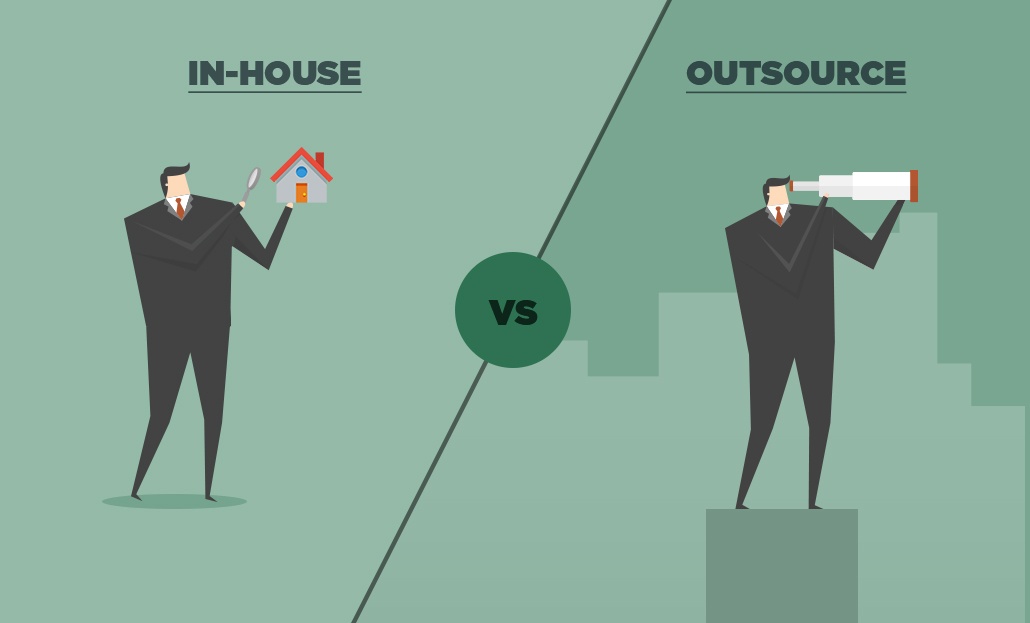In-House vs Outsource
50 Defining In-house vs Outsourcing

In-house operations focus on running the day-to-day activities for NPO’s within the organization rather than hiring groups externally. This allows organizations to have complete control of their activities and leverage their current resources. Outsourcing, on the other hand, is when organizations hire other groups or entities to take on specific tasks. This ensures the NPO utilizes experts or groups that specialize in a certain field of the operation to avoid any unnecessary mistakes.
Differentiating In-house vs Outsourcing
In-house
In-house operations occur when organizations make use of their own personnel and team to conduct activities rather than working with others outside of the campaign. One of the main reasons to keep activities in-house is for complete control, this reduces the risks involved with involving entities not directly a part of the process. Another benefit is proprietary information is not released to third parties which is important if you have sensitive information regarding your organization.
Examples of In-house activities
- Handling financials within the organization
- Technical support
- Day-to-day activities
NPO’s can utilize input and insight from their current team to take on various activities. Instead of issuing requests for a list of commodities or tasks, the project team can organize resources among themselves instead. Existing personnel can compile creative approaches for adding value to the IMC campaign. They have the ability to offer design alternatives, unique utilization of resources, and scheduling alternatives that meet all the campaign requirements and by in housing reduce the total project cost. The organization will often assign someone from their team to monitor relationships and provide support from project resources to help ensure success throughout the process.
Outsourcing
Outsourcing is when an organization decides to collaborate with third parties to complete certain tasks that may be difficult, time-consuming or expensive to do internally. There are many ways in which Non-for-profits can utilize outsourcing to benefit their operation, such as hospitals contracting with physicians rather than hiring medical staff, as this could make more sense for them financially and in terms of time management.
Reasons for Outsourcing
- Cost of production
- Save time and energy for internal resources
- Reduced downtime
- Efficiency for operation
- Reach a wider range of knowledgeable personnel
Different types of outsourcing:
- Multi-sourcing
- Process-specific outsourcing
- Offshore outsourcing
- Project outsourcing
Resource Planning for NPO’s
The use of a master schedule is important to ensure resources are working at an efficient rate and organized within the spectrum of the campaign’s vision. This type of schedule ensures volunteers and resources are organized in a way that allows for smooth operation in a given campaign. Other factors to consider are maintenance, relationships, changes, among others that must be analyzed consistently as this decision is a key part of the process. Effective planning allows NPOs to:
- Seek necessary support
- Maintain consistency throughout operations
- Expand their network through positive relationships
- Leverage resources they possess
Decision Matrix: Make or Buy
1. Strategic Alliance
High strategic importance, low operational performance. If an NPO decides to form this alliance with another entity, both partners control of the task and work together while remaining independent.
2. In-house (Make)
This allows the organization to have the maximum amount of control over the spectrum of activities. It places high importance on performance and high importance on strategy.
3. Outsource
As previously mentioned, NPOs may decide to hire or work with other groups to aid in the completion of certain tasks that may be difficult to perform on their own.
4. Elimination
Certain tasks may not hold the necessary importance to continue expending resources towards, so organizations may choose to eliminate or remove the task in totality.
Attribution
This page contains material taken from:
OpenTextBC. (n.d). Pulling it Together: Resource Planning. Retrieved from OpenTextBC: https://opentextbc.ca/businessopenstax/chapter/pulling-it-together-resource-planning/
Pressbooks. (n.d). 9.4 Procurement of Goods. Retrieved from Pressbooks: https://pm4id.org/chapter/9-4-procurement-of-goods/
Sardar, S. (2016, March 3). A Sustainable Outsourcing Strategy Regarding Cost, Capacity Flexibility, and Risk in a Textile Supply Chain. Retrieved from MDPI: https://www.mdpi.com/2071-1050/8/3/234/htm
Wikipedia. (n.d). Outsourcing. Retrieved from Wikipedia: https://simple.wikipedia.org/wiki/Outsourcing
When organizations make use of their own personnel and team to conduct activities rather than working with others outside of the campaign.
The delegation of key management areas to outside vendors, contractors or suppliers, usually on a relatively long-term basis.

